Sharing is caring!
Work task boxes for autism classrooms are a great way to keep students with autism engaged and motivated in the classroom. I don’t believe I’ve ever heard a teacher of students with autism say they had too many work boxes. Whether it’s a set of academic task cards or basic skills like put-in tasks, our students need a wide variety of material to work on the same concepts in order to generalize their skills and for the practice.
Different Types of Task Boxes You Need- and a Free One Below
Consequently I am always trying to think of new and interesting ideas for independent work tasks, and for general task boxes (i.e., used out of the work task system). As we all know, tasks that require no or limited laminating and Velcro are always winners. Tasks that are easy to make score high for me as well. Keeping in mind that sometimes we need simple task boxes, like a 1-piece errorless puzzle. And sometimes the concept may be more complex but the task can still be simple to make.
Whether you teach special education students generally or specifically autistic children, I believe that independent work stations are key. I’ve even used independent work systems with students in general education when students work on their own.
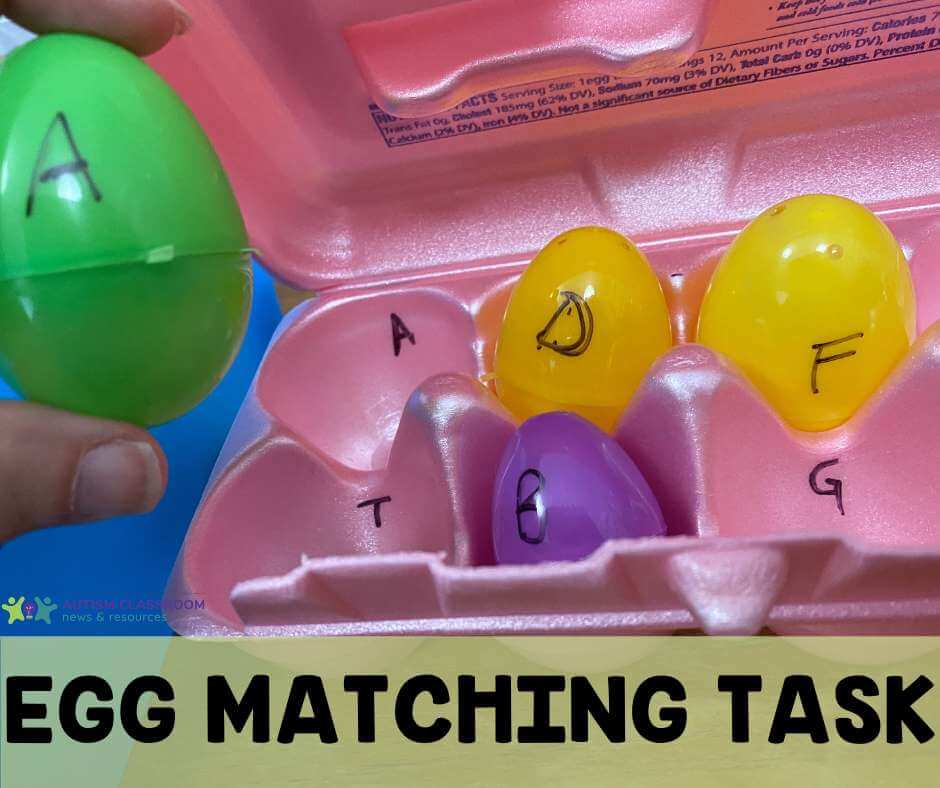
These simple-to-make task boxes for autism and other special learning needs are great for any special education classroom. I’ve tried to use examples that can be used with all different ages as well.
In addition I have a free digital download in the resource library to help you beef up your task box system. I’ll talk about them and show some pictures within the post and there is a link at the bottom to grab them for free.
Create Easter Egg Task Boxes
I love activities with plastic eggs partly because they work well with a variety of skills. They are an easy and cheap way to work on packaging items. Or you can make academic tasks out of them from matching letters to life skills packaging money to match a price. They also can be great for students who need more simple put-in tasks. And you can use them for things like basic math skills like addition and subtraction.
I love using plastic eggs because they are colorful and engaging and there are so many things you can do with them. They are also an uncommon type of material, so students sometimes will engage with them because they eliminate pencil-paper types of activities.
I’ve written several posts using plastic eggs for different types of skills. Some examples are having students simply package the eggs in an egg carton. This works well for students who are working on those basic skills. Another is having them match the same color of top and bottom of the egg when each has a number.
![Academic work tasks with plastic eggs-1 of 4 simple-to-make task boxes for autism classrooms [picture of plastic eggs with numbers and letters written on them in egg carton]](https://autismclassroomresources.com/wp-content/uploads/2023/03/4-simple-to-make-task-boxes-for-autism-classrooms-image-1-1024x576.jpg)
In one of the pictures above, students complete the addition problem (adding the number on top to the one on the bottom) and place it in the egg carton with that number on it. they also match numbers and add numbers to match to a total slot in the egg carton.
By the way, another great reason for using plastic eggs in independent work stations is that students can practice their fine motor skills when opening or closing them.
Sorting Nouns and Verbs with Popsicle Sticks
Popsicle sticks are simple items that provide another cheap material that you can use in a ton of different ways. In this example the students are sorting by whether the picture depicts a noun or a verb. Similar tasks can be created to have students sort by feature (e.g., color), function (i.e., purpose), or category.

You can see that in the picture below of the shoebox task. Shoebox tasks are great for students who aren’t quite ready to organize their own materials. You can read more about shoebox tasks in this blog post.
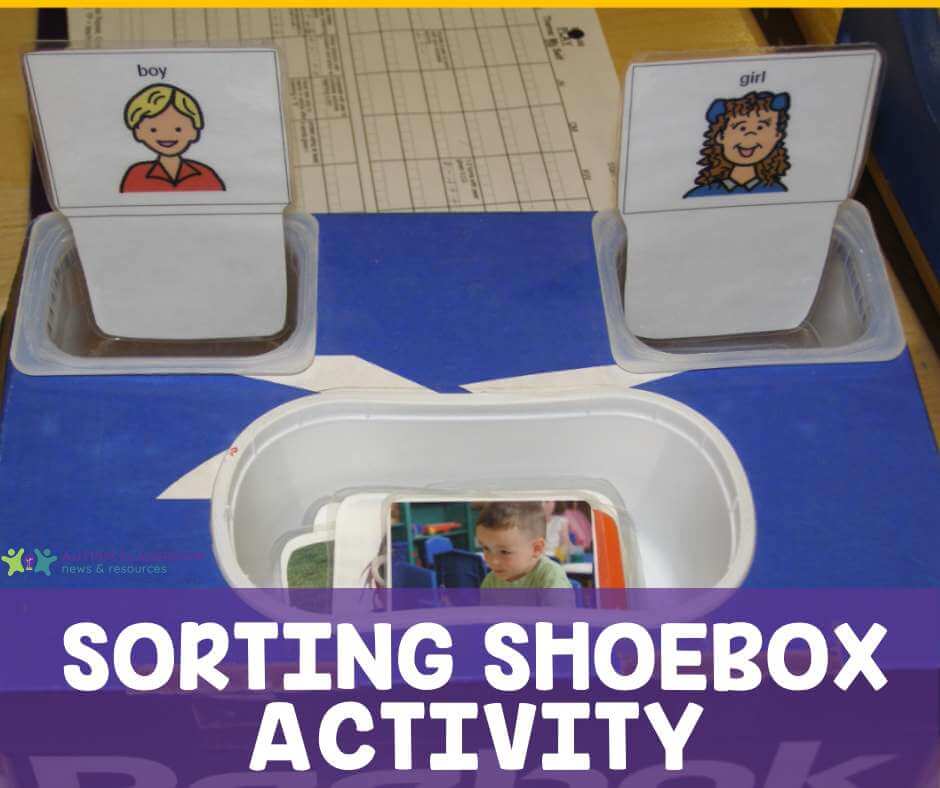
Work Tasks for Autism: Sorting Items with File Folders or Sorting Mats
The next task is using sorting. Sorting is a crucial skill for students to work on, but it’s also a great task box filler for task box systems. The question in sorting tasks is the type of task box you need to make.
You can use using common materials for younger students, like farm animals vs. food or sorting different shapes. Or use a file folder or sorting mats to practice sorting by category or characteristic, as you see with the flower sorting mats below. These are great for early childhood and elementary aged special needs students.
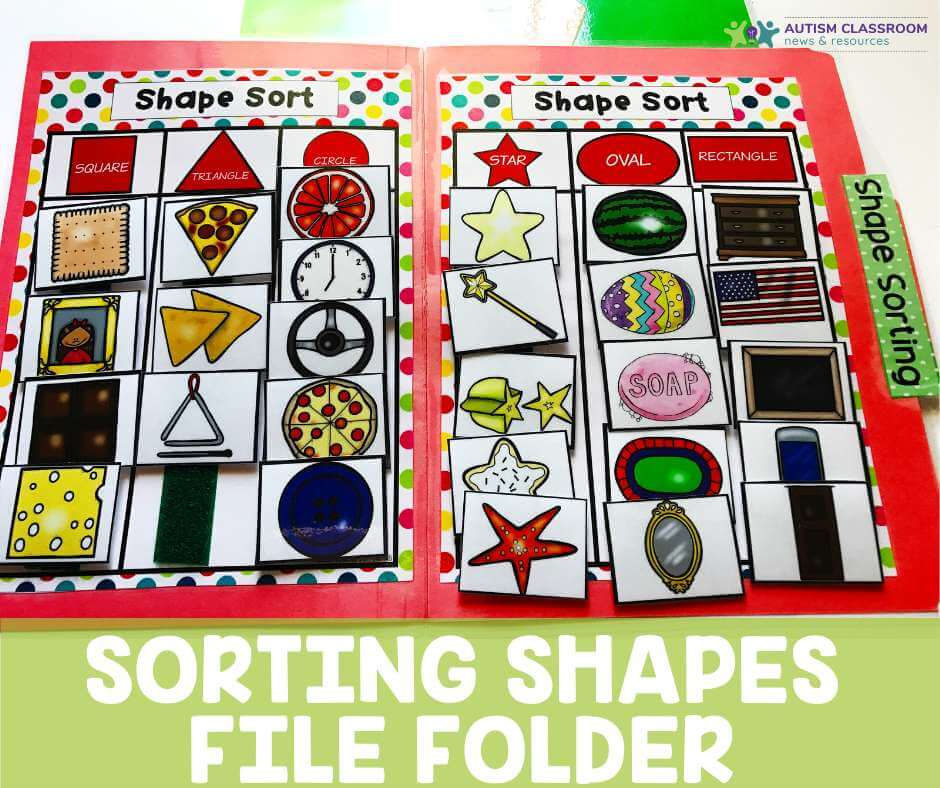
Work Tasks Ideas for Students in Life Skills and Functional Curricula
For older students and life skills students, you want to look for more functional materials that they would need to complete sorting in independent tasks. You don’t want them sorting farm animals, unless they live on a farm and that serves a function for them.
For these students, think about functional items you have around your house. I have a ton of play card decks with missing cards. They aren’t good for much other than making card houses. But they are great if you want a student to practice sorting by color or pattern or whatever is on the cards. In the task below, I set it up so students are separating out the red cards from the blue cards. This is much like what my family does between rounds of group solitaire or gin rummy.
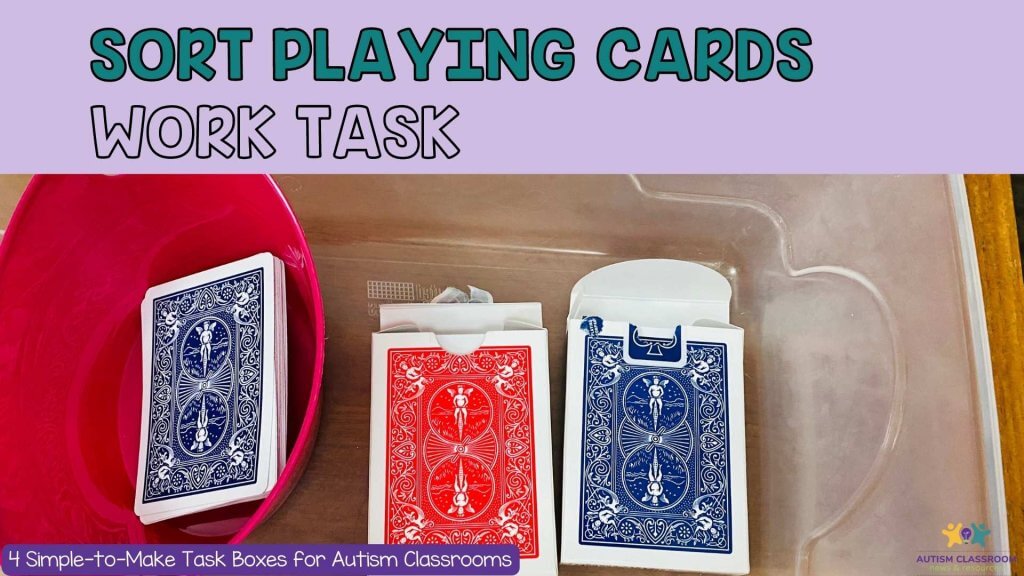
Similarly you could have the students count out the number of cards to deal a hand. While you can and should work on this in real life, such as during a card game, you might want the student to practice the skill by dealing out the correct number of cards in a bin or envelope.
Building to Match a Sample
Finally, this is a free set of cards that you can download from our resource library and teach students to build with the blocks to match the card. This task is great for fine motor skills, attention to detail and spatial awareness. It’s also great if you have a student whose favorite activity is interlocking blocks.

Another advantage to it for young children is that you are also teaching some initial building play. These are skills that would be useful in an early childhood setting for a student on the autism spectrum who will have some basic building skills going into the play area.
Who Has Ever Said, I Have Too Many Work Boxes?
Believe me, special education teachers can never have too many work tasks for autism. Our students can use them them to work on completing a simple task by themselves. Or they can be used within an independent work system to learn to complete a series of tasks.
I hope this has given you work task ideas as well as ways to work with your students who need some extra work on being independent. Work boxes are a great tool for filling in waiting time and keeping students engaged. I use them that way in table tasks and talk about it in this post.
Similarly, work boxes that meet certain criteria (e.g., having a clear beginning and end to the task) and that students have mastered can be put into independent work systems. You can learn more about setting up independent work stations in your classroom in this post.
Looking for different types of task boxes? Grab posts on independent work here including on Quick Tip Tuesday work tasks. Or find them in my store ready to be assembled and used here.
And you can grab a variety of tools below for building independent skills with independent work systems. The starter kits have a set of symbols for the task schedule and everything you need to get the work system set up, including collecting data. In addition there are sample educational goals for independent work in those as well.


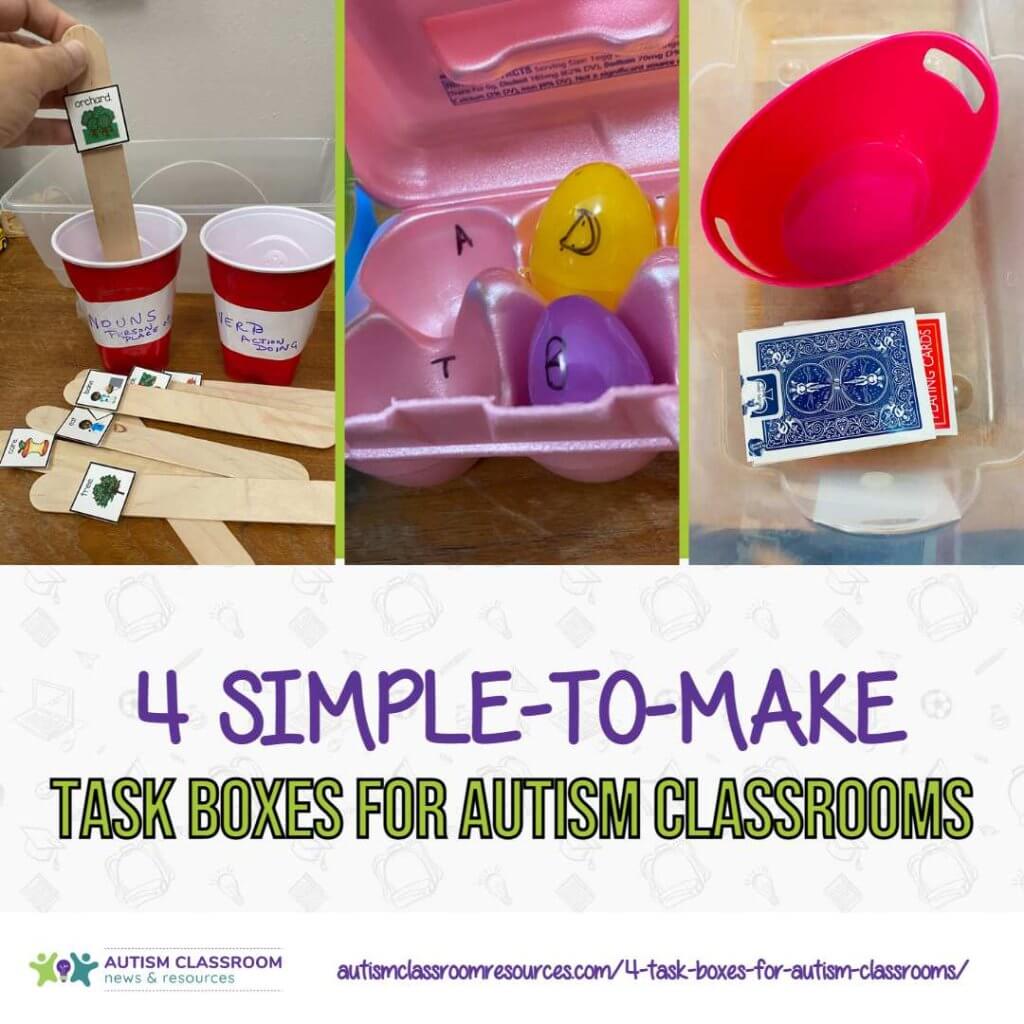


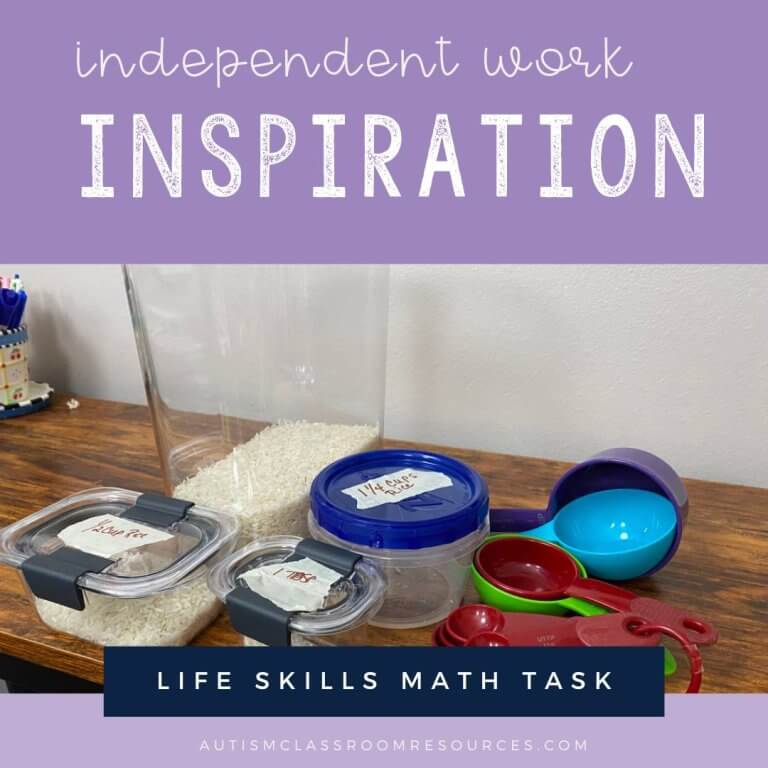

![Independent Work-3 Ways It can Become Your Best Classroom Management Tool [A sorting task in a shoebox to sort nouns from verbs on popsicle sticks into plastic cups]](https://autismclassroomresources.com/wp-content/uploads/2023/06/BLOG-22208-3-Ways-Task-Boxes-and-IW-Help-Classroom-Management-2-768x644.jpg)


